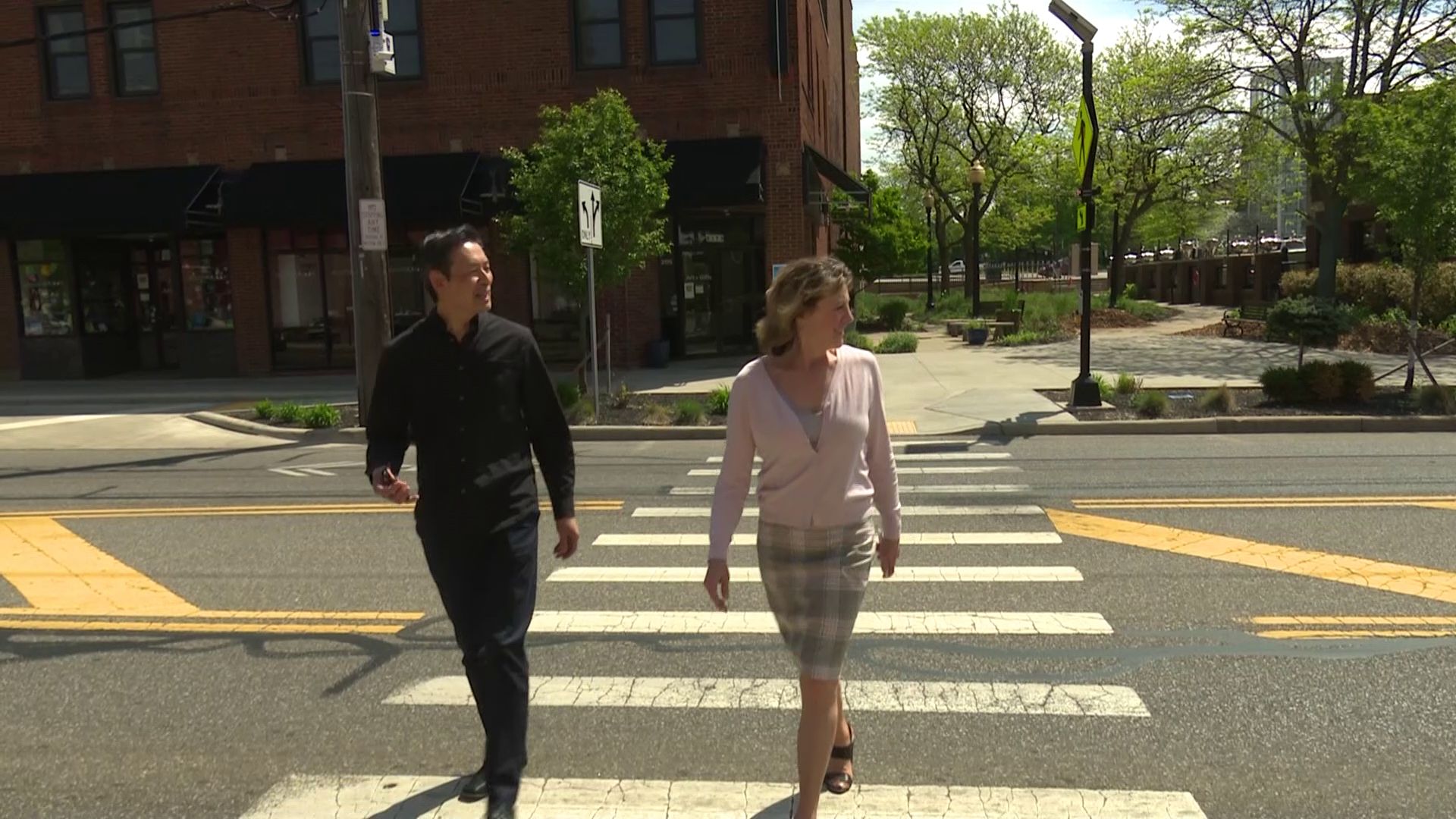Among Plans To Make Streets Safer, Cleveland Heights’ Plan Stands Out
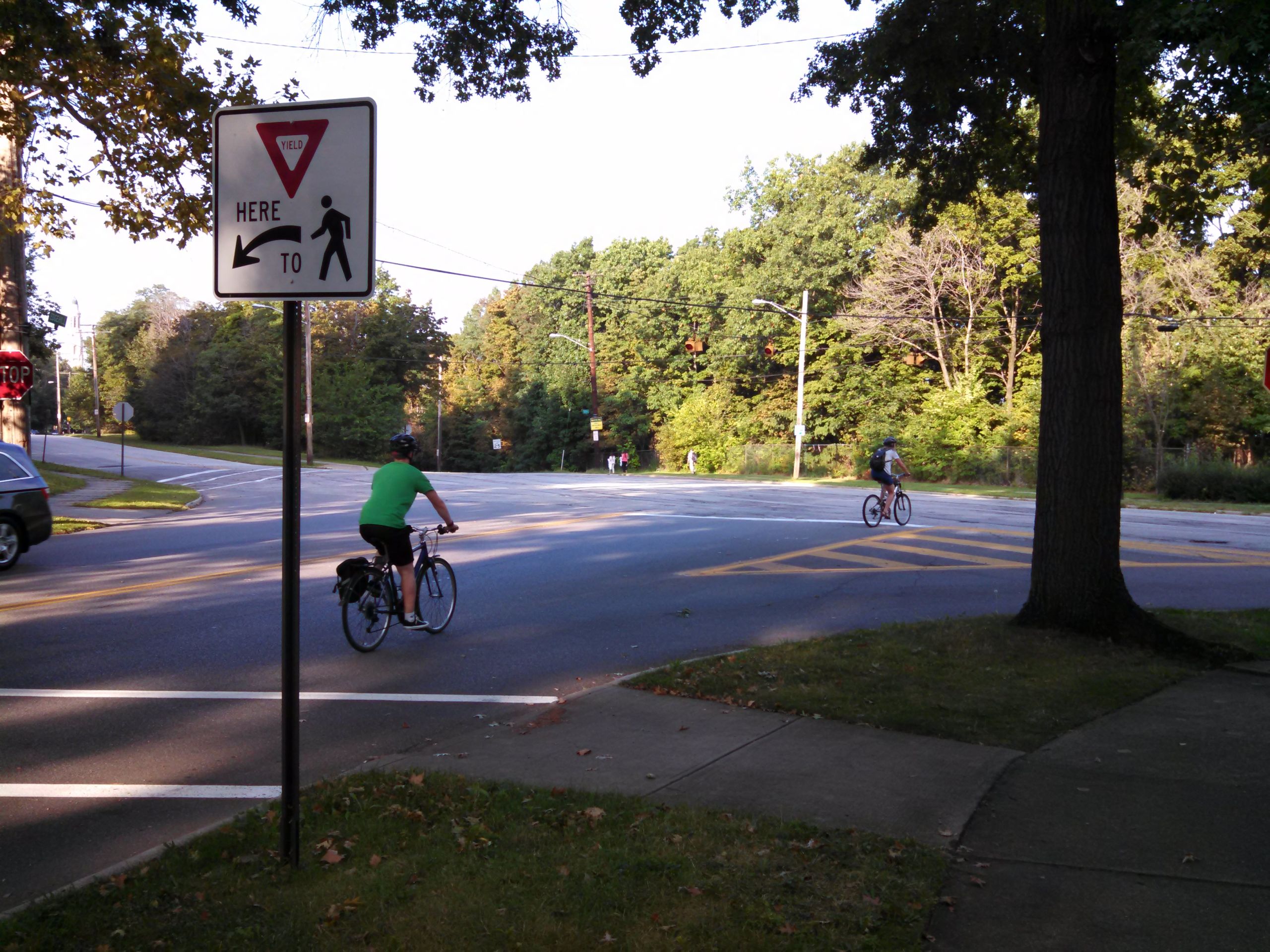
Ernest Durbin III is a dedicated bicyclist. And I mean dedicated.
“In September of last year, I decided to cycle outdoors, every day, for a year. I’m 20 days away of 365 days straight outside,” he said.

Ernest Durbin stands with his bicycle on Lee Road, at the corner of E. Overlook Road in Cleveland Heights, where he was hit by a car while cycling in 2018.
Ernest Durbin stands with his bicycle on Lee Road, at the corner of E. Overlook Road in Cleveland Heights, where he was hit by a car while cycling in 2018.
That means he’s cycled in sunshine, rain and snow around Cleveland Heights, where he lives and works. But his biggest challenge isn’t inclement weather. It’s cars.
Durbin was hit by one at the juncture of Lee and E. Overlook roads, a busy intersection near a popular supermarket, Zagara’s Marketplace.
“I was coming down Lee Road here and I got into the turn lane and I was waiting for traffic to clear so I could turn in here,” he said, gesturing toward the street.
“Right as traffic cleared a woman doing the same thing from E. Overlook jumped that stop sign and turned out and hit me as she was trying to turn left.”
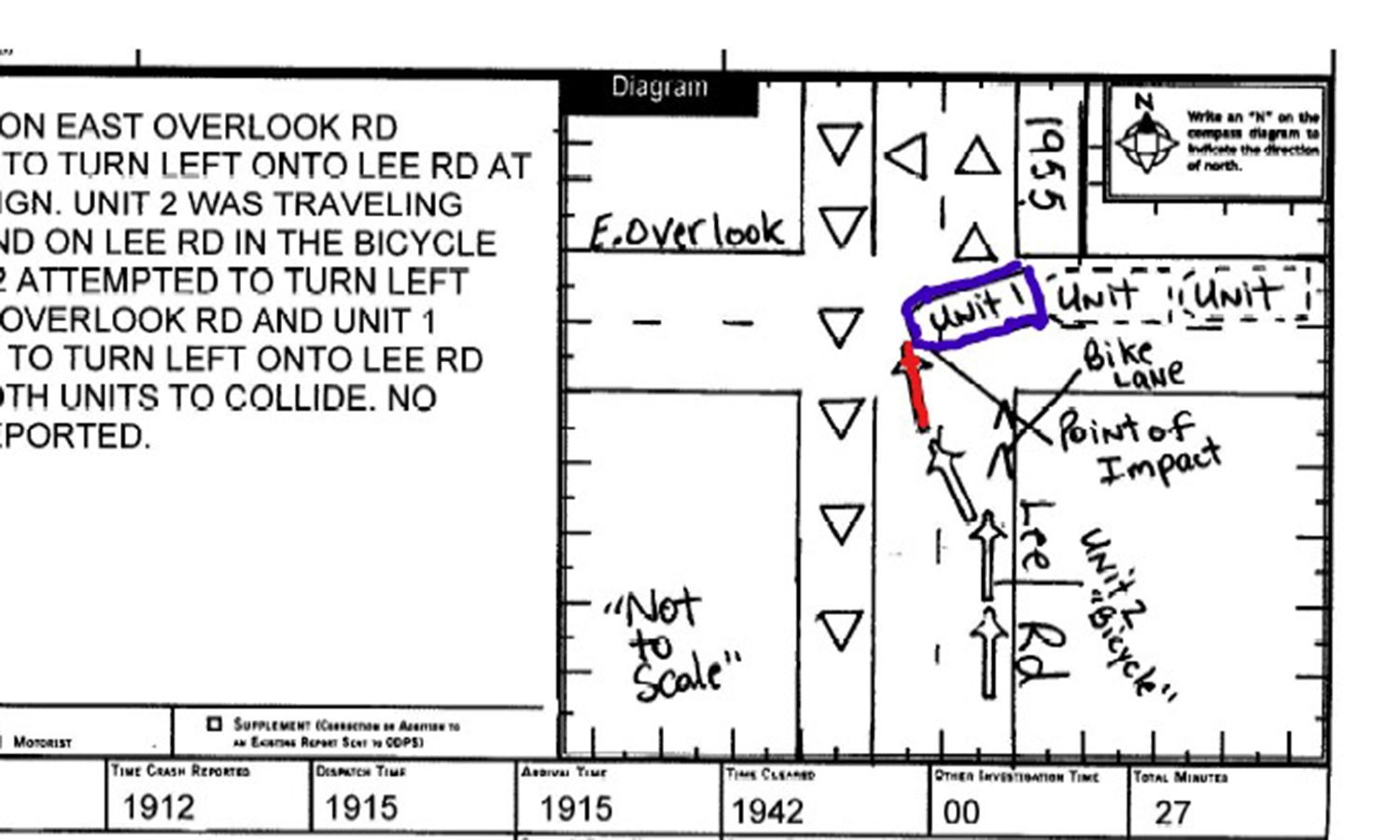
A detail from a Cleveland Heights police officer’s sketch of the crash involving a car and bicyclist Ernest Durbin on Nov. 27, 2018. [Cleveland Heights Police Department]
A detail from a Cleveland Heights police officer’s sketch of the crash involving a car and bicyclist Ernest Durbin on Nov. 27, 2018. [Cleveland Heights Police Department]
Durbin was lucky. He suffered minor injuries.
“My knee was damaged. I couldn’t really, like, run as much as I’d like to for a few months until it recovered,” he said.
Our Dangerous Roadways
Traffic deaths are down overall, due in part to safer cars.
But pedestrian and cyclist deaths continue to rise.
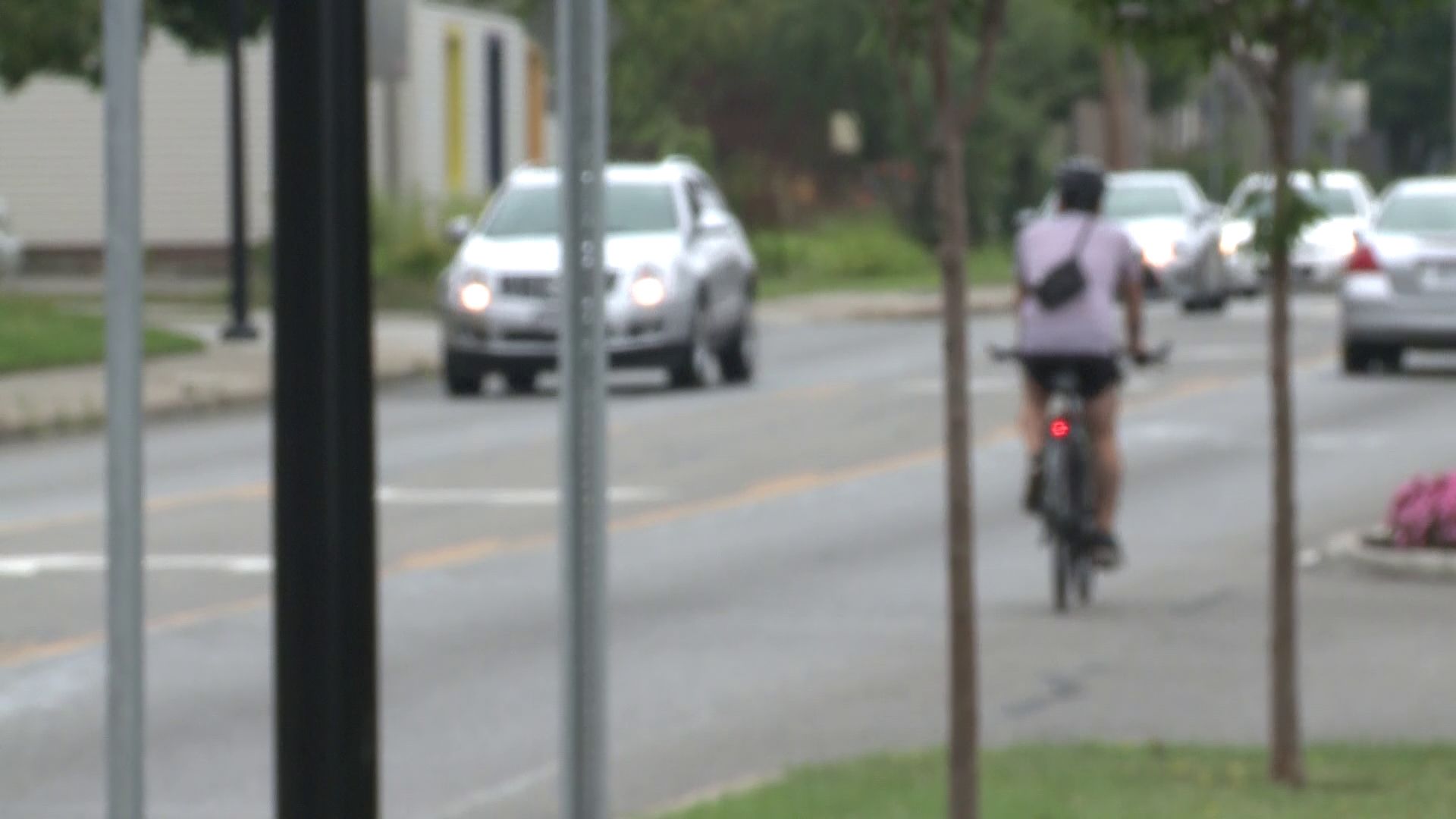
An analysis by ideastream of police crash reports shows Durbin was one of 11 cyclists and 11 pedestrians hit by cars in Cleveland Heights last year.
The crashes were scattered throughout the city, but a map of their locations, created by Cleveland Heights officials, show some hot spots. They include the Cedar-Lee commercial district, a multi-block stretch of restaurants, shops, bars and a movie theater on Lee Road south of Cedar Road, and Coventry Village, another business and entertainment district on Coventry Road between Mayfield Road and Euclid Heights Boulevard.
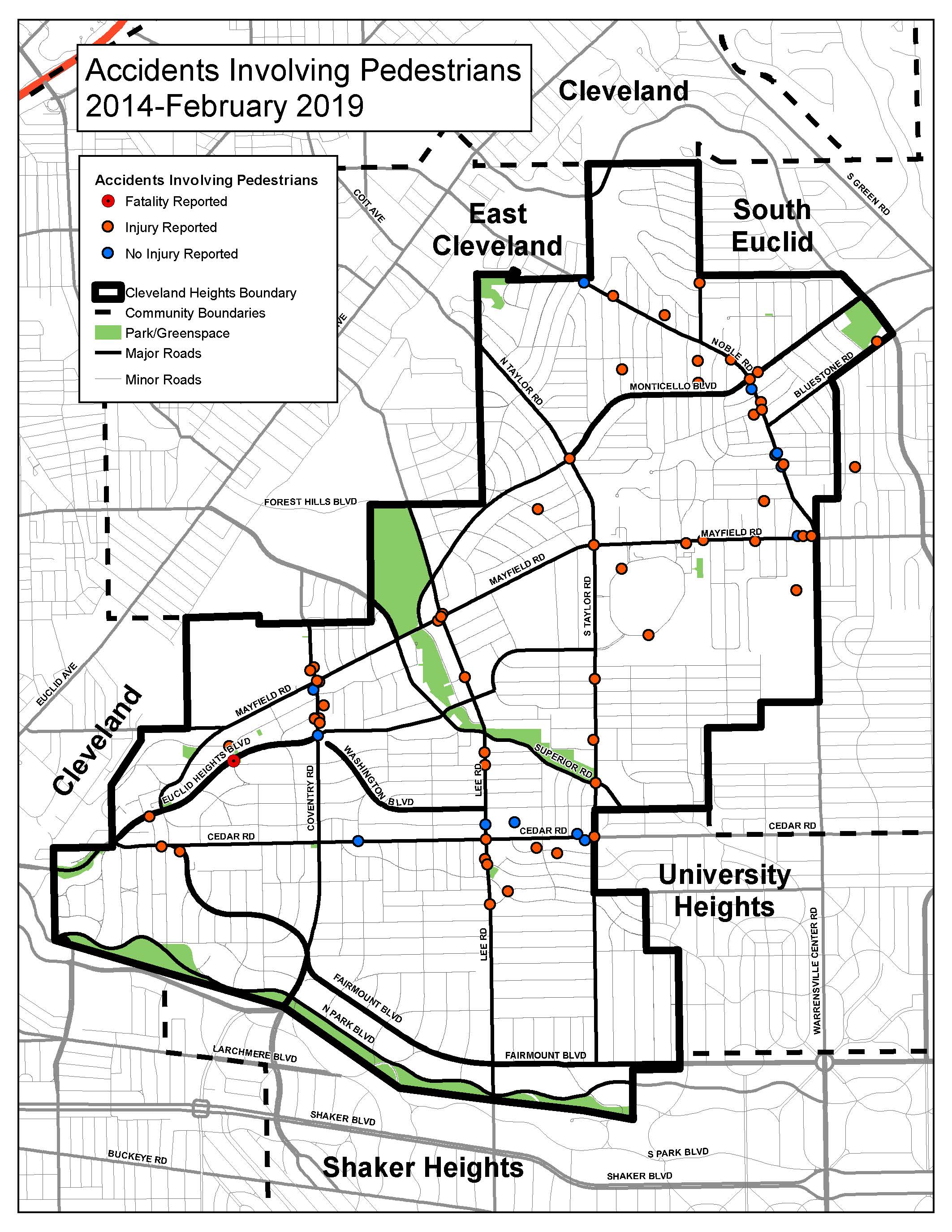
A map by Cleveland Heights officials that shows where pedestrians were hit from 2014 through February 2019, as reported by police. Note the concentrations along Lee, Coventry and Noble roads. [City of Cleveland Heights]
A map that shows where pedestrian crashes occurred in Cleveland Heights from 2014 through February 2019. [City of Cleveland Heights]
ideastream’s in-depth local reporting is made possible by donations from supporters like you.
Join us as a Member now.
ideastream.org/donate

Nationally, 2018 was a grim year for cyclists and pedestrians. Recent statistics from the National Highway Traffic Safety Administration (NHTSA) show that while overall traffic fatalities fell 2.7% from 2017, pedestrian deaths rose more than 3%, to 6,283. Bicycle fatalities increased more than 6%, to 857.
Both figures are the highest since 1990, according to the NHTSA.
The trend over the last 10 years is especially alarming.
Pedestrian deaths have ballooned 69% in urban areas from 2009 to 2018, while cyclist deaths have jumped 48%. The increases far outpace population growth in those areas; the report, citing U.S. Census Bureau figures, notes population grew 13% in urban areas from 2008 to 2017.
In Cleveland Heights, cyclist crashes had fallen to less than five by 2011, but rose sharply to 13 in 2014. Cars have hit, on average, 11 cyclists a year since.

A map by Cleveland Heights officials that shows the locations where bicyclists were hit from 2014 through February 2019, as reported by police. Note the cluster along Lee Road, south of Cedar Road. The crash involving bicyclist Ernest Durbin happened on Lee Road north of Cedar, near Superior Road. [City of Cleveland Heights]
A map by Cleveland Heights officials that shows the locations where bicyclists were hit from 2014 through February 2019, as reported by police. Note the cluster along Lee Road, south of Cedar Road. The crash involving bicyclist Ernest Durbin happened on Lee Road north of Cedar, near Superior Road. [City of Cleveland Heights]
Ernest Durbin said biking around Cleveland Heights can be “pretty hairy at times.”
“People tend to be impatient at intersections,” he said, “and that leads to cars doing things that might not seem reasonable to try to get the light or swerve around somebody who’s stopped to turn.”
“Making It Better For You!”
Cleveland Heights’ Complete Streets Policy
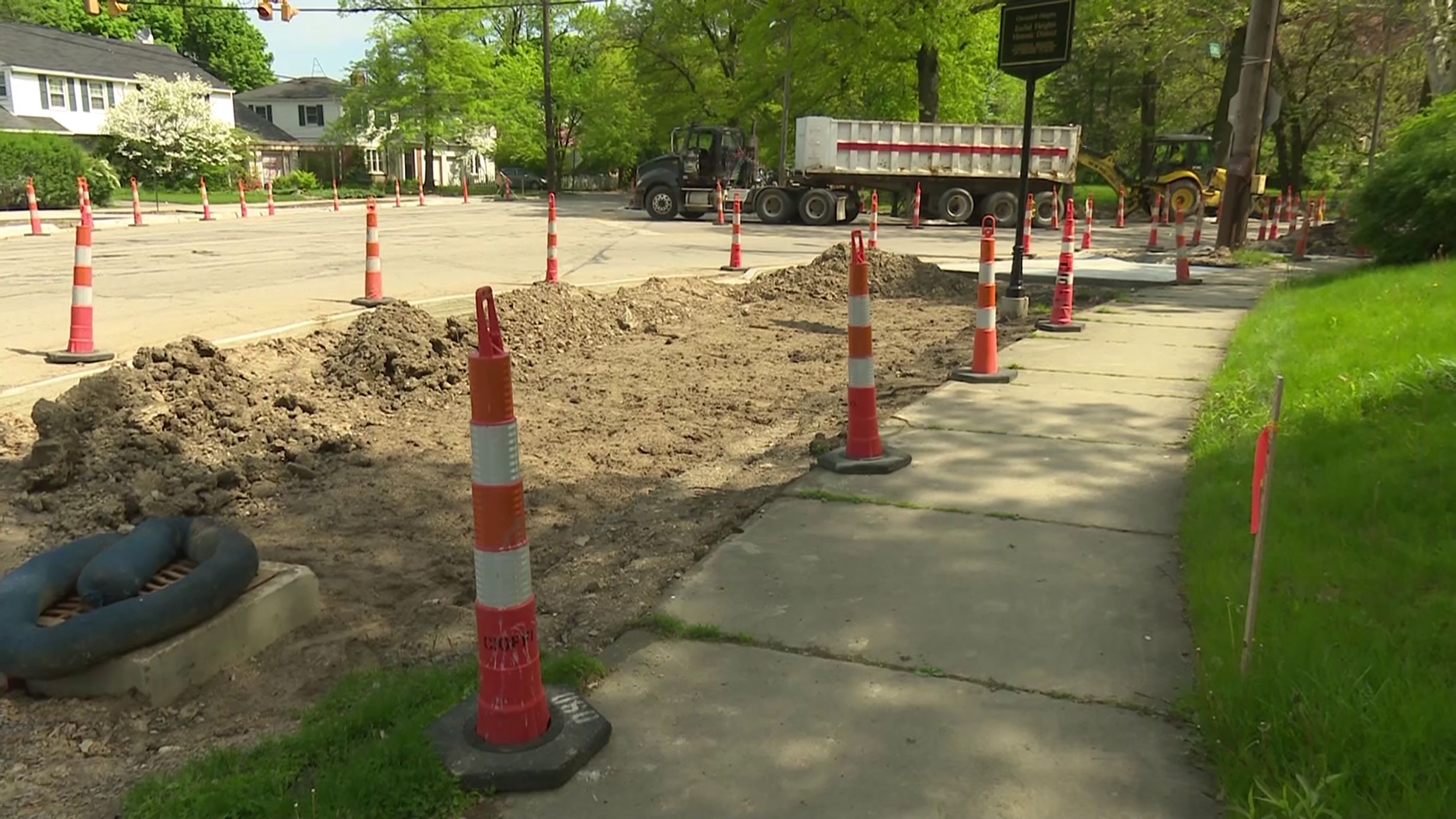
2018 was notable for having the highest national rates of pedestrian and bicyclist fatalities since 1990, but it was significant locally for another reason. It’s when Cleveland Heights’ City Council approved a Complete Streets policy aimed at making the city’s streets safer and more accommodating for pedestrians, cyclists and others who want to get around town without getting into a car.
Richard Wong, the city’s longtime planning director, took me to see Complete Streets changes already underway at Overlook and Edgehill roads.
The streets meet each other at awkward angles, like a pair of crossed legs. Wong explained the city was bumping out the curbs to make the streets narrower and easier to cross. It was also making the intersection a four-way stop.
A 360 degree view of the intersection of Overlook and Edgehill roads. The view shows Complete Streets construction to narrow the intersection. [Google Earth]
A 360 degree view of the intersection of Overlook and Edgehill roads. The view shows Complete Streets construction to narrow the intersection. [Google Earth]
Prior to the changes, motorists driving south on Overlook Road had the right-of-way and could cruise right through the intersection.
“So the mindset is, you put your bicyclist or pedestrian hat on and figure, what can I do to make it better for them? Slow down the car, make the car stop at the intersection,” noted Wong.
He pointed out other additions to the intersection, gesturing toward the curb of the sidewalk where we were standing.
“Curb cuts. Shorter crosswalks. Painting the crosswalks so they’re high visibility, easy to see.”
You put your bicyclist or pedestrian hat on and figure, what can I do to make it better for them?
Thousands of other communities have Complete Streets policies. Columbus has had one since 2008. Cleveland passed one in 2011. And Akron launched a Complete Streets advisory commission two years ago.
What makes Cleveland Heights different is that its policy could be considered one of the most far-reaching and comprehensive to date.
Earlier this year, the National Complete Streets Coalition, a project of the advocacy group Smart Growth America, named it the best policy of 2018. Cleveland Heights earned 91 points out of a possible 100, a surprisingly high score, given that the coalition changed its scoring system to make it tougher.
“We expected, in grading policies this year, that the scores would drop massively compared to how they’d been in previous years, because of how high we’d raised the bar,” said Heather Zaccaro, program manager for the National Complete Streets Coalition. “Cleveland Heights met that.”
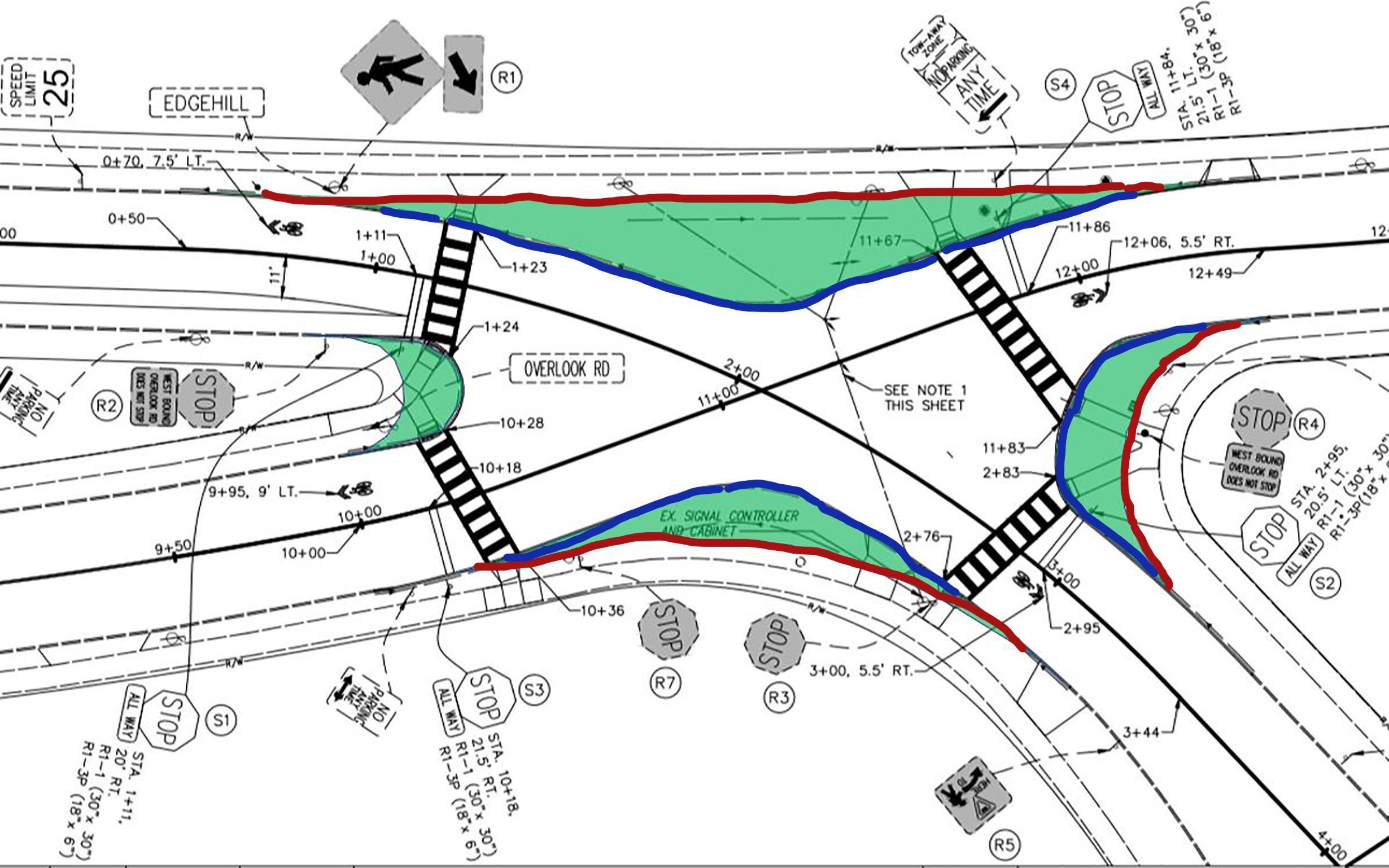
An engineer’s rendering of the Complete Streets changes to the intersection of Overlook and Edgehill roads in Cleveland Heights, Ohio. The old curb lines are indicated in red. The new curb lines are in blue. The areas shaded green are where crews removed asphalt to narrow the roadways and to add catch basins to slow and treat stormwater runoff. [Richard Wong / City of Cleveland Heights]
[Richard Wong / City of Cleveland Heights]
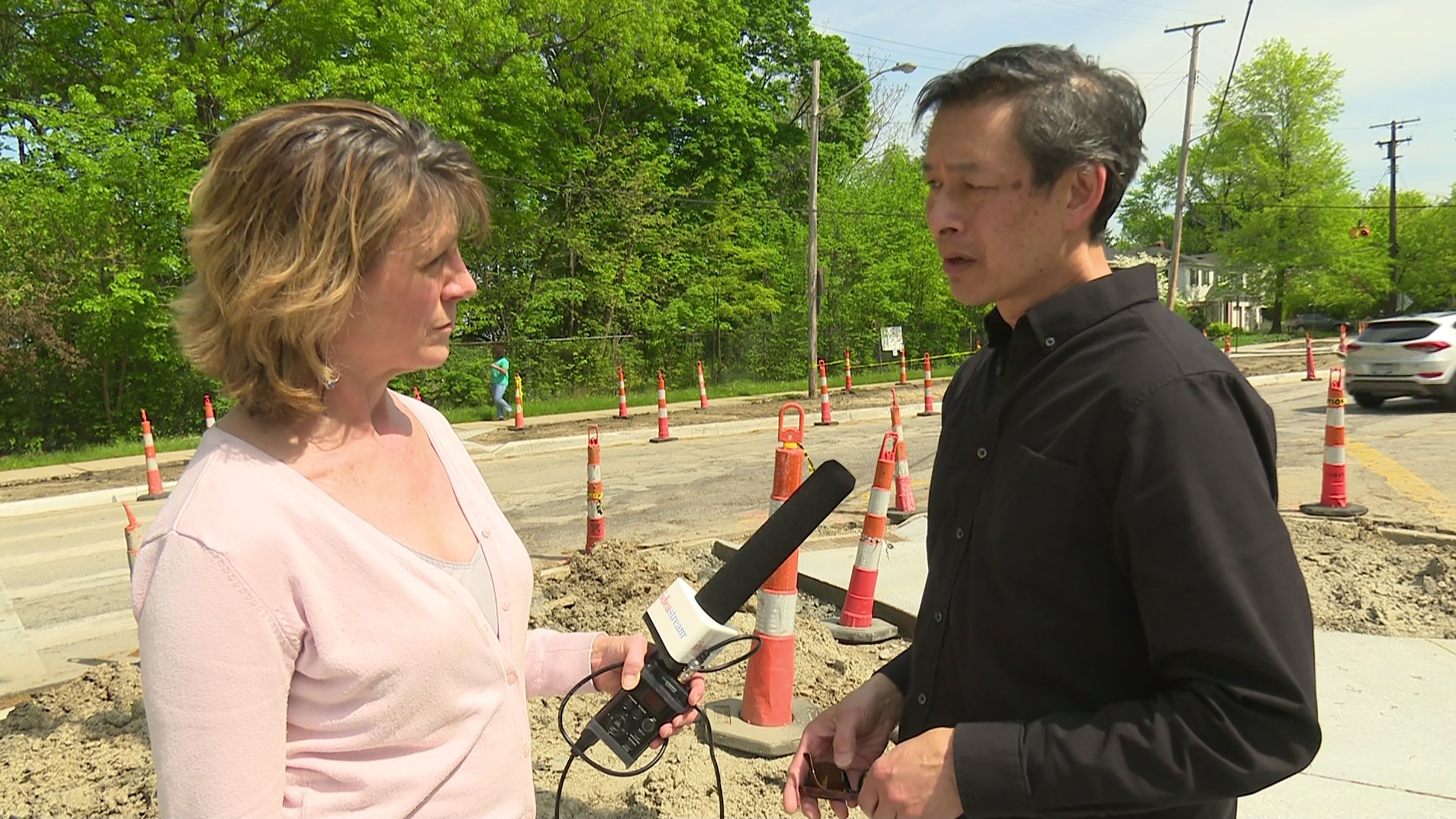
ideastream’s Amy Eddings interviewing Richard Wong, planning director for the City of Cleveland Heights, at the intersection of Edgehill and Overlook roads, where Complete Streets changes are underway. [Natalia Garcia / ideastream]
ideastream’s Amy Eddings interviewing Richard Wong, planning director for the City of Cleveland Heights, at the intersection of Edgehill and Overlook roads, where Complete Streets changes are underway. [Natalia Garcia / ideastream]
From Cleveland Heights’ Complete and Green Street Policy:
Definition. “Complete and Green Streets” are roadways designed and operated to safely and comfortably accommodate users of all ages and abilities, including cyclists, pedestrians, transit riders, elderly, wheelchair users, deliver and service personnel, and emergency responders; and to reduce, accommodate and slow stormwater runoff as part of a comprehensive stormwater management system.
1. Vision and Intent.
1.2. The City shall develop a safe, comfortable, reliable, efficient, integrated and completely connected multimodal transportation network providing access, mobility, safety and connection to all users.
5. Jurisdiction.
5.1 All transportation infrastructure and street design and construction projects requiring funding or approval by the City of Cleveland Heights shall adhere to this policy.
7. Land Use and Context Sensitivity.
7.1 The City shall require specific evidence in all new or revised land use policies, plans, zoning ordinances or equivalent documents how they support the City’s Complete and Green Streets Vision.
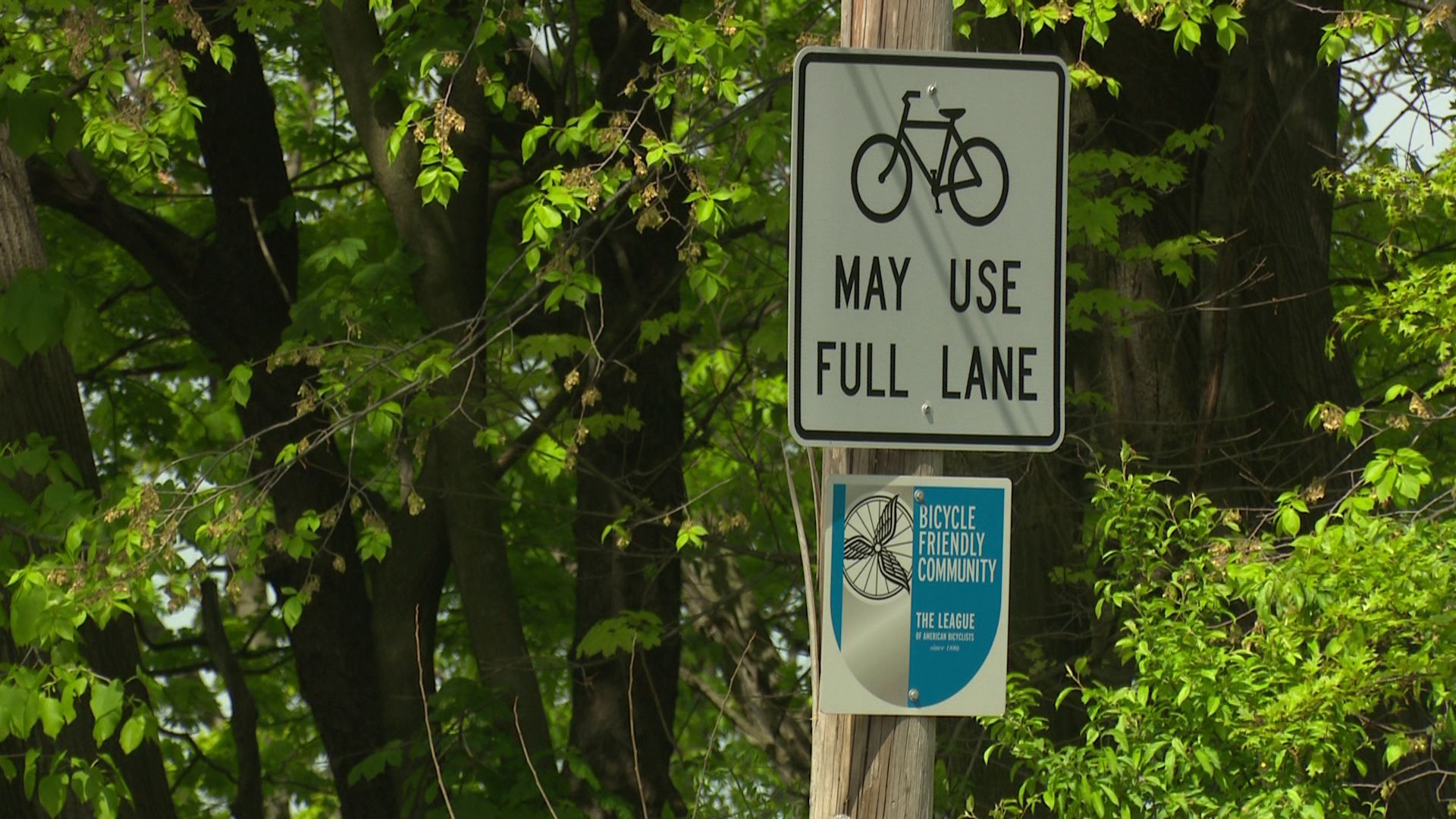
Heather Zaccaro said the coalition changed its grading standards out of a sense of frustration over the continuing rise in pedestrian and cyclist deaths. A study by the coalition found older adults, people of color and people in low-income communities bear a higher share of this harm, especially in the South. She said that this year, the coalition started putting a stronger emphasis on equity and implementation.
“We have realized, over 10 years of doing this work, that in order for a policy to be successful there has to be real clarity not only on what needs to change but who needs to play a role in changing it. When does that change need to happen? How does that change need to happen?” she said.
“‘Musts’ and ‘shalls’ are what get you an A grade, and it’s what got Cleveland Heights an A grade.”
She said there were elements in Cleveland Heights’ plan that other candidates for the coalition’s recognition didn’t do, like a provision requiring safe accommodations for people walking or biking during construction.
“Often you’ll see, walking down the street when there’s a massive construction project, even if the street has a nice, wide sidewalk or protected space for cyclists, during construction, that’s often taken over,” said Zaccaro. “There are missing connections, people are having to cross in dangerous places or go around. It’s one of the concerns about construction that nobody’s thought about before and it’s something that Cleveland Heights put in its policy that nobody else did.”
Zaccaro praised Cleveland Heights for spelling out its goals and its action steps in unequivocal terms, something many earlier policies had lacked.
“You know, I think [in] early iterations of Complete Streets, you may have a lot of that prevarication around, ‘We’ll get to this if we can,’” said Marc Lefkowitz, a citizen-member of Cleveland Heights’ Transportation Advisory Committee, which helped shape the policy.
“‘Musts’ and ‘shalls’ are what get you an A grade and it’s what got Cleveland Heights an A grade.”
From the City of Cleveland’s Complete and Green Streets Ordinance No. 798-11
Section 1. That the Director of Capital Projects is authorized to implement and enforce policies and guidelines related to Complete and Green Streets in all construction projects within the public right of way.
Section 4. That Green infrastructure or Complete Streets elements on resurfacing projects and other roadway maintenance projects conducted by the City of Cleveland shall be limited to minimal impact improvements that do not affect sub base, curbs and sidewalks or other elements outside the scope of a project of maintenance resurfacing. Elements that may be included are paint re-striping, sharrows, signage for cyclists or pedestrians and the use of recycled asphalt.
Section 5. That the Director of Capital Projects shall be authorized to consult an advisory committee [...] to review the improvement and any requests for exemptions from the Complete and Green Streets guidelines and, upon consultation with other City Departments, approve exemptions where appropriate.
From Akron's Code of Ordinances on the Function and Duties of the Complete Streets Commission:
A. The Complete Streets Commission shall consult in the development, implementation, and operation of a comprehensive complete, livable, and green streets plan/strategy.
2. Advise, consult, and work collaboratively with City personnel in the future construction of complete, livable, and green streets improvements;
5. Advocate for further construction of complete, livable and green streets projects whenever it is in the best interest of the City to do so and act as a liaison between the City and individuals/groups interested in implementing complete, livable and/or green street projects.
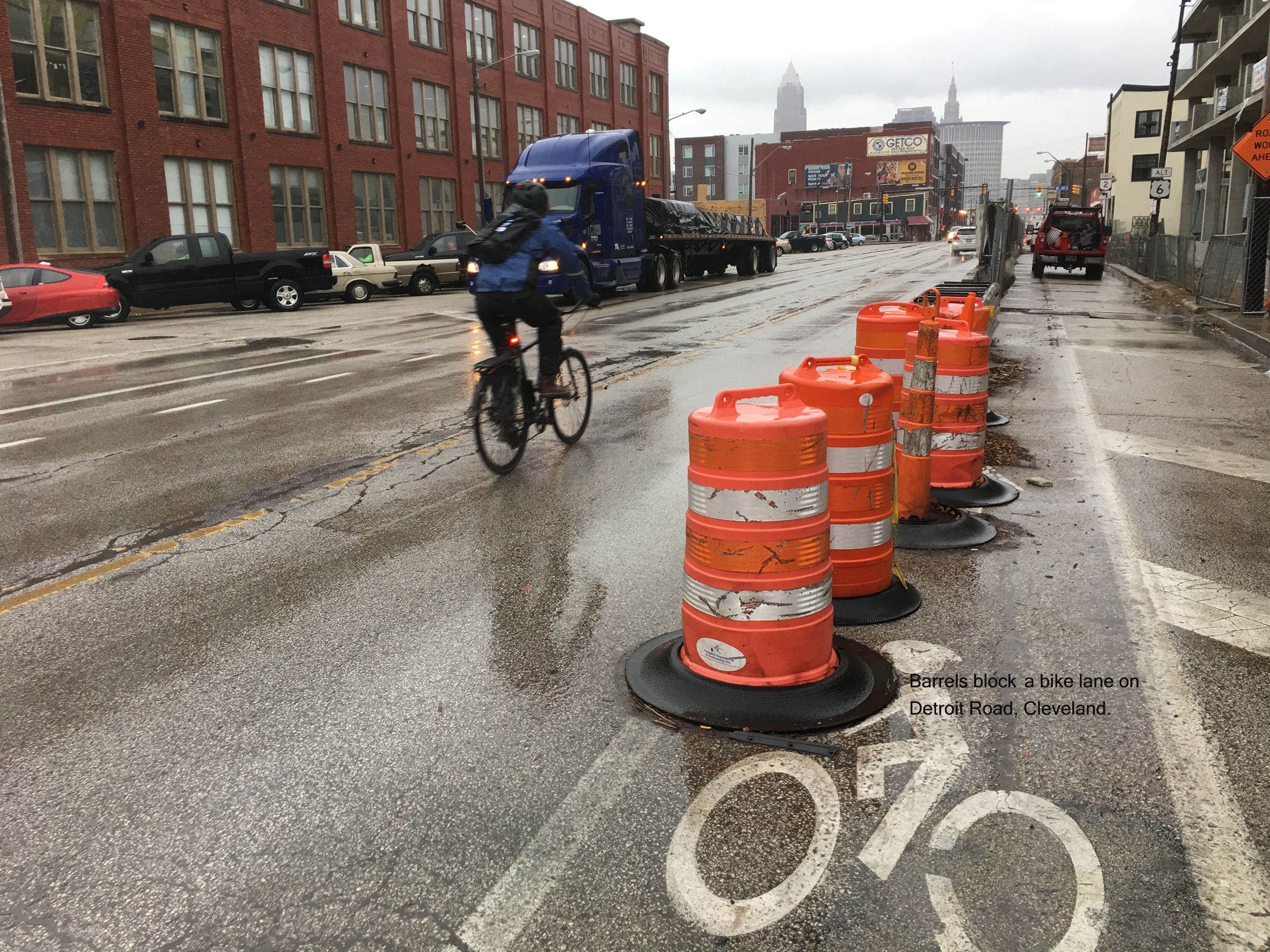
Edgehill and Overlook roads: Before and After Complete Streets Changes
At Overlook and Edgehill roads, Cleveland Heights’ Planning Director Richard Wong and I watched as construction workers reshaped the intersection to make it safer and, as Wong put it, more comfortable.
“It must be cool to see it becoming reality,” I told him.
“Yeah, and when it’s done, watching people use it,” he answered. “That’s the key: Are we helping somebody?”
As if on cue, a bicyclist zipped past us.
Wong gave a little cheer and added under his breath, “Making it better for you!”
